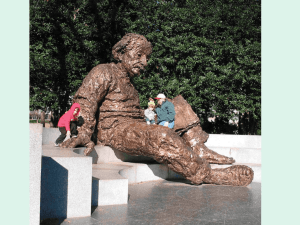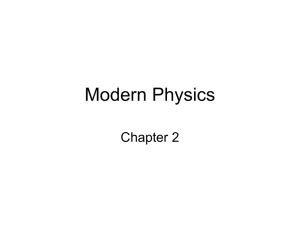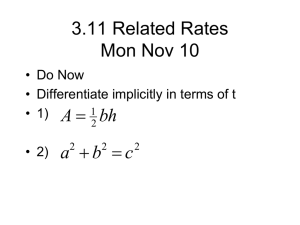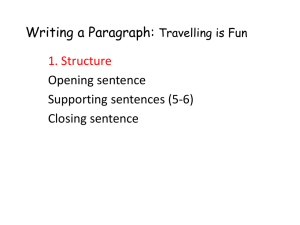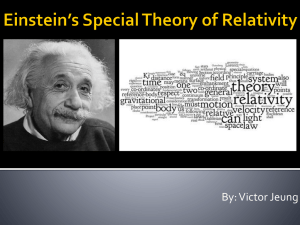Word file: Higher Physics: Special Relativity
advertisement
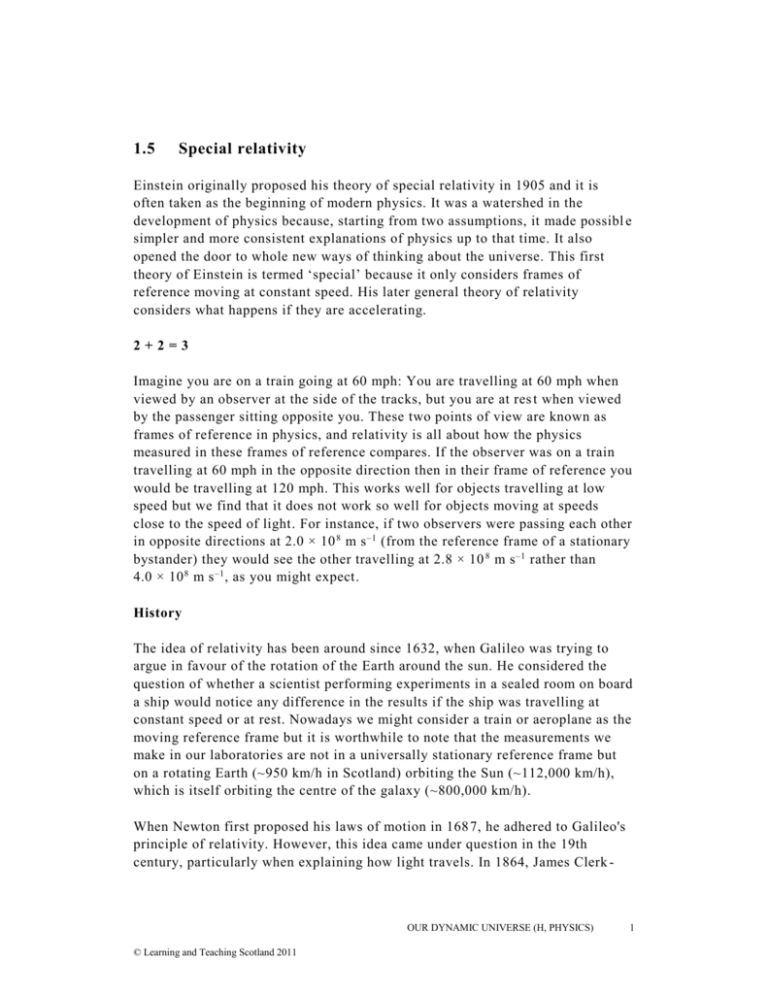
1.5 Special relativity Einstein originally proposed his theory of special relativity in 1905 and it is often taken as the beginning of modern physics. It was a watershed in the development of physics because, starting from two assumptions, it made possibl e simpler and more consistent explanations of physics up to that time. It also opened the door to whole new ways of thinking about the universe. This first theory of Einstein is termed ‘special’ because it only considers frames of reference moving at constant speed. His later general theory of relativity considers what happens if they are accelerating. 2+2=3 Imagine you are on a train going at 60 mph: You are travelling at 60 mph when viewed by an observer at the side of the tracks, but you are at res t when viewed by the passenger sitting opposite you. These two points of view are known as frames of reference in physics, and relativity is all about how the physics measured in these frames of reference compares. If the observer was on a train travelling at 60 mph in the opposite direction then in their frame of reference you would be travelling at 120 mph. This works well for objects travelling at low speed but we find that it does not work so well for objects moving at speeds close to the speed of light. For instance, if two observers were passing each other in opposite directions at 2.0 × 10 8 m s –1 (from the reference frame of a stationary bystander) they would see the other travelling at 2.8 × 10 8 m s –1 rather than 4.0 × 10 8 m s –1 , as you might expect. History The idea of relativity has been around since 1632, when Galileo was trying to argue in favour of the rotation of the Earth around the sun. He considered the question of whether a scientist performing experiments in a sealed room on board a ship would notice any difference in the results if the ship was travelling at constant speed or at rest. Nowadays we might consider a train or aeroplane as the moving reference frame but it is worthwhile to note that the measurements we make in our laboratories are not in a universally stationary reference frame but on a rotating Earth (~950 km/h in Scotland) orbiting the Sun (~112,000 km/h), which is itself orbiting the centre of the galaxy (~800,000 km/h). When Newton first proposed his laws of motion in 168 7, he adhered to Galileo's principle of relativity. However, this idea came under question in the 19th century, particularly when explaining how light travels. In 1864, James Clerk - OUR DYNAMIC UNIVERSE (H, PHYSICS) © Learning and Teaching Scotland 2011 1 Maxwell developed a theory of electromagnetism, which stated that light w as a wave that travelled through some yet to be discovered universal medium called the aether (pronounced Eether). This aether could be considered a stationary master frame of reference that spread throughout the whole universe, including the vacuum of space. In 1881, JJ Thomson (who also discovered the electron) noticed that the mass of an object in motion increased. His work and Maxwell’s were developed further to show that the increase in mass depended on the speed of motion. Heaviside and Searle (1888–1897) also observed that a moving electromagnetic field contracted in the direction of travel. These experimental observations and others could be consistent with the widely accepted theory that included the idea of the aether. However, the aether itself was proving difficult to find and there was also much debate about the nature of the aether itself. Was it stationary or was it affected by the motion of objects through it, a bit like a boat dragging some water along with it? A very important experiment was performed by Michelson and Morley in 1887, where light was sent in two beams at right angles to each other to mirrors, so that they could recombine again at the centre. Because of the movement of the Earth around the Sun and its movement around the cent re of the galaxy we would expect to see differences in the measurements as the Earth changed direction through the aether. However, this is now one of the most famous ‘failed’ experiments of physics as the two men were not able to prove the existence of the aether. Rather than accept that the aether didn’t actually exist, the scientists of their day considered that this was either down to lack of accuracy in the apparatus or that there were other theoretical reasons why the experiment didn’t work. However, there were a small number of scientists such as Lorentz and Poincaré who weren’t wholly convinced by the aether concept and were developing alternative theories. Einstein was also aware of Planck’s work in quantum physics, which stated that light could be thought of as a particle rather than a wave, an idea which did away with the need for an aether. This was also such a massive jump in thinking that there was a feeling that all the pillars of classical physics were open to challenge. So Einstein did not c ome up with his ideas in isolation but was widely influenced by other thinkers of his time. He was not an established scientist at this time but his work as a patent clerk involved a lot of study into synchronising clocks throughout the world, so he was of ten dealing with the relative nature of measurements of time. Although (or perhaps because) he had no access to scientific equipment he would consider the logical 2 OUR DYNAMIC UNIVERSE (H, PHYSICS) © Learning and Teaching Scotland 2011 consequences of scientific assumptions. He called these his ‘thought experiments’ or Gedanken in German. It is perhaps this unique combination of intellect and imagination that produced the most famous scientist of the 20th century. The principles 1. When two observers are moving at constant speeds relative to one another, they will observe the same laws of physics. 2. The speed of light (in a vacuum) is the same for all observers. This means that no matter how fast you go, you can never catch up with a beam of light, since it always travels at 3.0 × 10 8 m s –1 relative to you. If you (or anything made of matter) were able to travel as fast as light, then light couldn’t be moving away from you at that speed and that wouldn’t make sense – we can never see stationary light. Einstein started with just these two principles. These were two almost philosophical statements, which he could not prove to be true, but using them he was able to derive his theory of special relativity. The consequences of this theory could then be tested against what we observe to be true in the universe. It was also impressive that Einstein was able to derive all the results of his predecessors using just a few pages of working rather than the volumes of scientific writing they had needed. Time dilation A very simple thought experiment shows that one consequence of the speed o f light being the same for all observers is that time experienced by all observers is not necessarily the same. There is no universal clock that we can all refer to – we can simply make measurements of time as we experience it. Imagine you are on a spaceship travelling at constant speed (v) relative to a colleague on a space station. You are investigating a timing device based on the fact that the speed of light is constant. You fire a beam of light at a sensor and time how long it takes to arrive. From your point of view the light has less distance (l) to travel than from the point of view of your colleague on the space station (d). If you both observe the speed of light as the same then you cannot agree on when it arrives, ie both of you experience time i n a different way. OUR DYNAMIC UNIVERSE (H, PHYSICS) © Learning and Teaching Scotland 2011 3 movement of spaceship sensor l light source Your point of view, where the source and sensor are moving along together sensor d light source Your stationary colleague’s point of view, where the sensor moves after the light is fired The time for the experiment as observed by your stationary colleague ( t') is greater than the time observed by you when moving with the sensor ( t), ie what you might observe as taking 1 second could appear to take 2 seconds to your stationary colleague. Note that you would be unaware of any difference until you were able to meet up with your colleague again. Your body processes would continue at the same rate. The formula linking these can be shown to be: t' t 1 v2 c2 Note this is often written as t ' t 4 OUR DYNAMIC UNIVERSE (H, PHYSICS) © Learning and Teaching Scotland 2011 where γ is known as the Lorentz Factor. It is used often in the study of special relativity and is given by: 1 1 v2 c2 Worked example A rocket is travelling at a constant 2.7 × 10 8 m s –1 compared to an observer on Earth. The pilot measures the journey as taking 240 minutes. How long did the journey take when measured from Earth? Solution: t = 240 minutes v = 2.7 × 10 8 m s –1 c = 3 × 10 8 m s –1 t' = ? t' t' t v2 1 2 c 240 1 (2 7 10 8 ) 2 (3 10 8 ) 2 t' = 550 minutes An observer on Earth would measure the journey as tak ing 550 minutes, ie 550 minutes would have passed from their point of reference. 2 v2 v Note: 2 is the same as , which can make the calculation simpler, c c particularly if the speed is given in the form of a fraction of the speed of light, eg the speed in the above example could have been given as 0.9 times or 9/10 of the speed of light. The calculation can then be written as: 240 240 t' 550minutes 2 1 0 81 1 0 9 OUR DYNAMIC UNIVERSE (H, PHYSICS) © Learning and Teaching Scotland 2011 5 Why do we not notice these time differences in everyday life? A graph of the Lorentz factor versus speed (measured as a multiple of the speed of light) is shown below. We can see that for small speeds (ie less than 0.1 times the speed of light) the Lorentz factor is approximately 1 and relativistic effects are negli gibly small. Even 0.1 times the speed of light is 300,000 m s –1 or 1,080,000 km h –1 or about 675,000 mph – a tremendously fast speed compared to everyday life. However, the speed of satellites is fast enough that even these small changes will add up over time and affect the synchronisation of global positioning systems (GPS) and television broadcasters with users on the Earth. They have to be specially programmed to adapt for the effects of special relativity (and also general relativity, which is not covered here). Very precise measurements of these small changes in time have been performed on fast -flying aircraft and agree with predicted results within experimental error. 6 OUR DYNAMIC UNIVERSE (H, PHYSICS) © Learning and Teaching Scotland 2011 Further evidence in support of special relativity comes from the field of particle physics, in the form of the detection of a particle called a muon at the surface of the Earth. (Hopefully you will be able to build your own detector for these during the particle physics topic.) These are produced in the upper layers of the atmosphere by cosmic rays (high-energy protons from space). Their measured lifetime is about 2·2 μs and their speed is 99·9653% of the speed of light. Multiplying these together tells us that they should be able to travel about 600 m in their lifetime. However, muons are produced around 25 km above the surface of the Earth so they should not be detected at the surface. The fact that they are can be explained using time dilation. In the frame of reference of the muons, they survive for about 2·2 μs, but from our perspect ive this time is 84 μs because of to time dilation (you can check the calculations for yourself). This gives muons enough time to travel to the surface of the Earth. Length contraction Another implication of Einstein’s theory is the shortening of length when an object is moving. Consider the muons discussed above. Their large speed means they experience a longer lifetime due to time dilation. An equivalent way of thinking about this is that the muons experience the height of the atmosphere as smaller (or contracted) by the same amount as the time has increased (or dilated). A symmetrical formula for time dilation can be derived. Note that the contraction only takes place in the direction that the object is travelling: l' l 1 v2 c2 where l is the length as measured by the moving observer and l' is that measured by the stationary observer. Ladder paradox There is an apparent paradox thrown up by special relativity: consider a ladder that is just longer than a garage. If we fly the ladder at hi gh speed through the garage does length contraction mean that from our stationary perspective it fits inside the garage? How can this be reconciled with the fact that from the ladder’s reference frame the garage appears even shorter as it moves towards the ladder? The key to this question is simultaneity, ie whether different reference frames can agree on the time of particular events. In order for the ladder to fit in the garage the front of the ladder must be inside at the same time as the back of the ladder. Because of time dilation, the stationary observer (you) and a moving OUR DYNAMIC UNIVERSE (H, PHYSICS) © Learning and Teaching Scotland 2011 7 observer on the ladder cannot agree on when the front of the ladder reaches the far end of the garage or the rear of the ladder reaches the front. If you work out the equations carefully then you can show that even when the ladder is contracted, the front of the ladder and the back of the ladder will not both be inside the garage at the same time! 8 OUR DYNAMIC UNIVERSE (H, PHYSICS) © Learning and Teaching Scotland 2011


